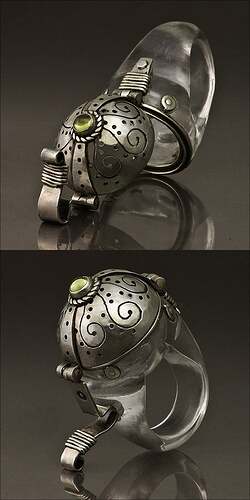Materials: sterling silver, plexiglass, peridot
Dimensions: 50mm x 44mm x 26mm
An other poison ring, inspired by the sea. Like most of my jewellery it is pressure proof up to 6.8 miles depth. The “trigger” of the poison ring lies on the next finger, so you can open it without anyone noticing it.
The ring itself was carved (drill, saw file sand) from plexi glass (acrylic glass). The rim and the lid are fabricated from silver, on the top there is an olivin (peridot).
The rim is connected to the plexi base by glue and 5 bolts.
Weight: 22.1 grams
Size: 7.25 (US)
Photo credit: Barbara Taramasso Lanfranco
János Gábor Varga
Blind Spot Jewellery
Campo Ligure, Italy
Once we have gained something with hard fight, we wish to save and protect it. All bags, pockets, gourds are about having a container with us at all times. As the jewellery we wear becomes a part of us, so does the contained treasure we place in it. As long as we survive, the treasure survives.
I was born in Budapest, Hungary in 1976. I graduated as an agronomist in 2002. Until I lived in my country of origin, my passion was animal breeding and ethnography. I did a 10 years long research on the ethnomedicine of animals, involving wonderful, exciting journeys in Transylvania, Ukraine and the Hungarian countryside. The time I spent working with pheasants, shepherds made a deep impact on me: the wisdom of those people, the way they work materials, the way they face the life.
First of all I learnt: there are no „simple people”. We are all bloody complicated.
And… the most beautiful finish on metal is the one a shiny scythe has at the end of the summer.
Then I left Hungary for England where I lived for nearly 3 years, this is where I started to make jewellery. As I spoke very bad English, jewellery become the way of expressing myself.
Starting a new life I become a farm worker, later cheese maker.
Searching for my home I left England and I emigrated to Italy. Here I started again from the beginning, without the knowledge of the language, place. I worked for two years as a goat herd, forest worker when finally I managed to become a full time jeweller. I have my own workshop in a small village in the mountains near to Genoa.
In my jewellery I recall desire and power. I want to give you the same feeling, like the little child feels, when he buckles on his plastic sword, and he thinks that he is powerful. That is a serious thing! It is natural, and we never outgrow it, at best we might deny it. But we are big guys/girls now, we are not allowed to do that anymore… Still, art often gives you similar power just simple with colors, shapes, voices. If you can wear these artifacts, I call them amulets, and that power will stay with you all the day, every day.
These containers and vessels definitely hold their place in the world of stunning art objects as well as in the world of metalsmithing.
Since the dawn of time humans have created containers to hold things that were important to them, from large vessels to hold food and harvests to intimate containers for small precious things. They might hold memories, ashes, medicine, beverage, fruit or food - but all spring from the imagination and skill of the maker. Some have specific religious functions, some are meant for everyday use. When one thinks of a vessel or container the inclination is to think of something with solid walls - yet many of these works involve the exploration of positive and negative space, and the use of negative space to help create the illusion of the wall of the vessel.
As the world’s largest jewelry related internet site, Ganoksin strives to develop exhibitions showcasing work from around the world. This exhibition was open to all metalsmiths, professional and amateur, advanced and beginner. Participants are from The Netherlands, the USA, Canada, Australia, Costa Rica, the United Kingdom, Israel, Hong Kong, Colombia, Romania, Italy, Ireland, Japan, Malaysia and Denmark. While most of the pieces are by an individual metalsmith, some are collaborations, one of three artists spanning 50 years.
In total 319 artists contributed 729 show pieces for the permanent online exhibition.
Objects in the exhibition include boxes, lockets, urns, ash containers, bowls, wine cups, reliquaries, match holders, vases, teapots, pitchers, sugar bowls, baskets, nests, pillboxes, clutches and a range of sculptural forms. A variety of techniques are showcased covering a wide range of metalsmithing techniques. Materials used include everything from gold and silver to less expensive metals. Ornamentation includes the addition of enamel, chasing and repousse’, gemstones and found objects.
The exhibition was curated by Beth Wicker, President of the North Carolina Society of Goldsmiths in the United States, and Adjunct Instructor at Northeastern Technical College in South Carolina. Director of the exhibition is Hanuman Aspler, founder of The Ganoksin Project, the world’s largest internet jewelry site.
